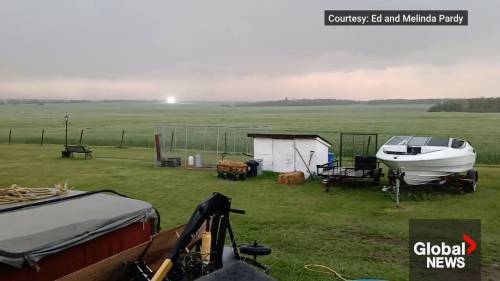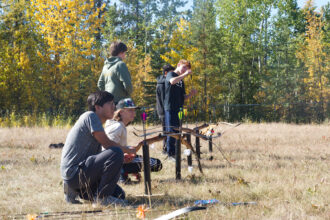A fleeting moment during a violent summer storm in Alberta has potentially revealed one of nature’s most mysterious and contested phenomena: ball lightning. Local resident Morgan Campbell captured what experts are now analyzing as a possible rare instance of this enigmatic electrical display while filming a thunderstorm that swept through central Alberta last week.
“I was just recording the lightning strikes when suddenly this glowing orb appeared,” Campbell told CO24 News. “It hovered for maybe three seconds before disappearing. I’ve never seen anything like it before—it was completely different from regular lightning.”
The video shows a luminous sphere roughly the size of a basketball moving horizontally across the sky, maintaining its shape before abruptly vanishing. Unlike typical lightning bolts that flash instantaneously, this phenomenon maintained its form briefly, displaying the characteristic behavior described in historical accounts of ball lightning.
Dr. Elena Mikhailova, atmospheric physicist at the University of Calgary, reviewed the footage and noted its significance. “What makes this recording particularly valuable is the clarity with which we can observe the object’s movement and luminosity patterns,” she explained. “Ball lightning sightings are exceedingly rare, with perhaps only one in 10,000 people ever witnessing it in their lifetime.”
Ball lightning remains one of meteorology’s most perplexing mysteries. Described as glowing, electric orbs that appear during thunderstorms, these phenomena typically range from pea-size to several meters in diameter and last between seconds and minutes—significantly longer than conventional lightning. The scientific community has debated their existence for centuries, with conclusive evidence difficult to obtain due to their unpredictability.
The Alberta footage comes at a time when Canadian meteorological researchers are increasingly focusing on extreme weather phenomena amid climate change concerns. The Prairie provinces have experienced particularly volatile storm seasons in recent years, creating more opportunities for documenting unusual atmospheric events.
“What makes ball lightning so fascinating is that we still don’t have complete consensus on its formation mechanism,” said Dr. James Thornton, meteorologist with Environment Canada. “Theories range from vaporized silicon particles to microwave cavities in the atmosphere, but definitive proof remains elusive.”
This Alberta sighting joins only a handful of documented cases with video evidence. The most famous scientific observation occurred in 2014, when Chinese researchers accidentally recorded ball lightning with spectrographs during a thunderstorm study in Qinghai province, confirming elements consistent with soil composition in the luminous sphere.
For the scientific community, Campbell’s footage represents a valuable addition to the limited empirical evidence available. The Canadian Atmospheric Research Network has requested the original video files for further analysis, hoping to extract additional data on this poorly understood natural phenomenon.
As summer storm season continues across the Canadian prairies, meteorologists encourage residents to remain vigilant but safe when observing unusual weather events. “Document what you can, but always from a protected location,” warns Thornton. “No scientific discovery is worth risking personal safety during severe weather.”
As researchers continue to analyze this rare footage from Alberta, one question remains at the forefront: could increasing documentation of these elusive phenomena finally help solve one of nature’s longest-standing atmospheric mysteries?










